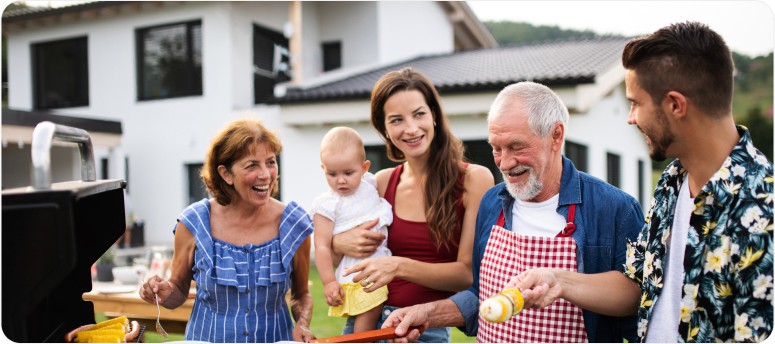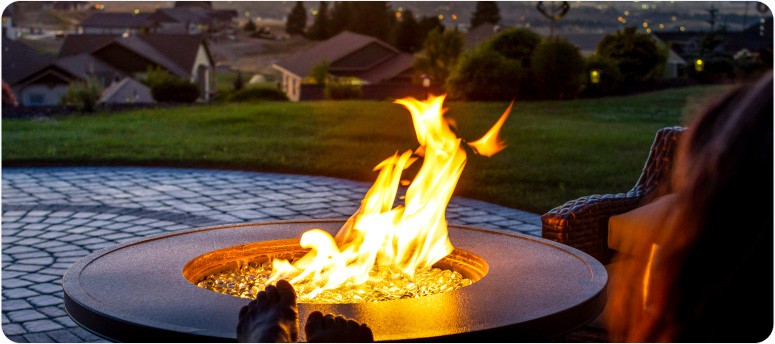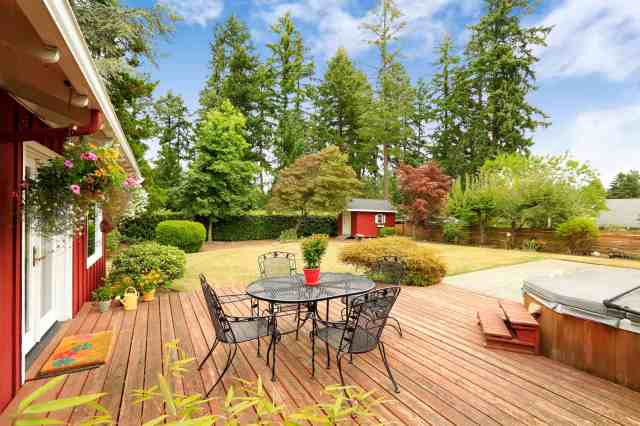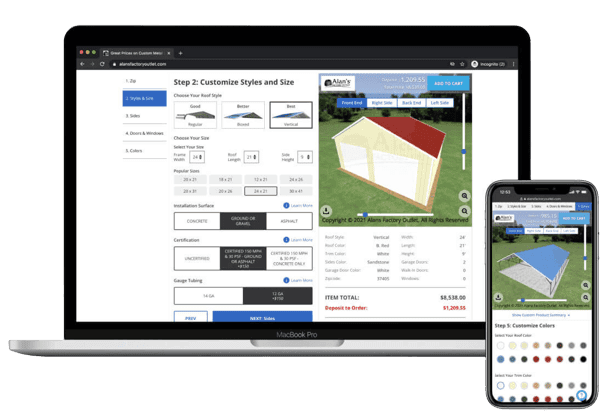Imagine stepping out your backdoor into a sanctuary of your creation. The sun shines on your growing garden, birds and insects happily buzz around, and your kids or pets are playing on a lush lawn as you lounge on comfortable outdoor furniture. Anyone who has experienced something similar to this pleasant scenario can tell you the power of a well-designed outdoor space.
This isn’t just wishful thinking. Research indicates that spending time in nature helps your mental health by reducing stress and increasing happiness. By creating a beautiful and functional outdoor space, you’re not just enhancing your property—you’re investing in your health and lifestyle.
But it’s not always easy to design your dreamscape. Fortunately, we’ve compiled some tips to help you create an outdoor space where you’ll love spending time.
1. Create Purpose for Every Part of Your Yard

Good landscape design starts with crafting a purpose for every part of your yard. This doesn’t mean that a physical element must occupy every square foot. Rather, it’s about creating a balance between functionality and design where each area of your outdoor space serves a defined role.
One way to bring this concept to life is by maximizing available space. Regardless of the size of your yard, you can use every square foot effectively to make your outdoor area feel larger and more functional.
Here are a few ideas for landscaping designs in small spaces:
- Map out different areas for various purposes: For example, designate specific zones for seating, gardening, storage, and other activities. This approach helps create a sense of order and organization, making your space feel larger and more functional.
- Use smaller elements to create the illusion of a larger area: For example, you can use compact furniture or petite plant varieties to make your space seem bigger than it is.
- Use vertical space to your advantage: If you have a small yard, consider adding vertical gardens or trellises to grow plants upward instead of outward.
- Use multipurpose structures: Structures like pergolas can serve multiple functions, such as providing shade and supporting climbing plants.
Customizing structures to fit these spaces is also a great idea. For instance, you might consider installing a gazebo for a shaded seating area, a garden shed for storage, a carport for vehicle protection, or a garage workshop.
2. Establish an Outdoor Entertainment Area

There’s nothing like a movie night outside or a backyard party with your friends and family. But without an established outdoor entertainment area, you’re left with out-of-place furniture and an uninviting space. So consider the following tips when putting together your outdoor area.
Choose Comfortable Outdoor Furniture
Comfort is always front of mind, and when choosing your outdoor furniture, this is especially important. But you’ll also want to keep in mind the different seasons and how your selected furniture will fare throughout the year.
For example, consider investing in all-weather furniture that can withstand exposure without wearing down. Select patio chairs, an outdoor hammock, and other durable furniture you can enjoy year-round. Likewise, opt for furniture with built-in storage for cushions during inclement weather. This saves you time and energy that would otherwise go into moving cushions in and out of storage.
A few good options for outdoor furniture materials include cast aluminum, wrought iron, resin wicker, and teak. These materials are known for their durability and weather resistance. Of course, there are other options out there as well, depending on your budget and style.
Add a Grill and Fire Pit

For those who love a good backyard cookout, adding a grill opens up opportunities for outdoor dining and barbecues—while a fire pit creates a cozy focal point and provides warmth for cooler evenings.
Equip for Weather
Depending on where you live, weather conditions can greatly affect the usability of your outdoor entertainment area. Consider installing umbrellas or sun shades to protect against sunlight during the day. If you have the space and budget, building a pavilion or pergola can provide a more permanent solution for shade and shelter.
Additionally, making space in a garage or shed for seasonal storage can help protect your outdoor furniture and accessories during severe weather or off-season months.
Don’t Forget about Lighting

A backyard space isn’t complete without the right lighting setup. You need to set the ambiance of your outdoor spaces and ensure that everyone can see their way around. A few good options include:
- Illuminating your walkways to prevent trips and falls with solar-powered path lights
- Creating a warm and inviting atmosphere with string lights or lanterns
- Installing motion sensor floodlights for added security and visibility at night
With thoughtful touches and attention to detail, you can create a space that keeps your guests comfortable and entertained.
3. Plant with Purpose

Planting with purpose means creating a space both visually appealing and functional. Consider what kind of plants, trees, and touches you’d like to have and what purpose they serve.
Some ideas include:
- Vegetable garden boxes: Garden boxes can make gardening fun—it’s easier on your back, offers better soil control, and adds charm to your outdoor space. Plus, it deters pests and prevents weeds in your veggie patch.
- Ornamental gardens: Ornamental gardens aren’t just for decoration. Through thoughtful planning, they can provide shade and privacy. For example, planting tall shrubs or trees along your property’s edge creates a natural privacy screen, shielding your home.
- Plant for wildlife: Add plants that attract pollinators, such as bees and butterflies, or that provide food for birds.
- Edible landscaping: Consider planting fruit trees, berry bushes, or herbs throughout your yard.
Depending on how you want to use your outdoor space, there are endless options for planting with purpose. You can even create a small farm or mini orchard in your backyard.
4. Build in Storage Solutions

If you’ve got a large backyard or have a family of outdoor enthusiasts, chances are you have a lot of equipment and accessories to store. If you don’t have the right storage solution, your yard is sure to become cluttered.
A custom shed is a great way to complete your outdoor space. A well-designed shed can add beauty to the overall design of your yard, and it is a great place to keep your lawn equipment and gardening tools and supplies out of sight.
If you’re curious about how much a custom shed for your outdoor oasis would cost, access our convenient tool below to design the perfect backyard shed for your home.
[Button: Design Your Shed]
More Helpful Tips for Landscape Design
Remember the six basic principles of landscape design—proportion, transition, unity, rhythm, balance, and localization. They help you create a cohesive and attractive layout by understanding how various elements work together. To achieve these principles, follow these steps:
- Start with a focal point and work your way outwards. This central unity theme establishes harmony and coherence, as all other elements relate to or complement it.
- Don’t forget about scale and proportion. Consider your yard’s size and elements when choosing plants and accessories. Proportion maintains balance and prevents overpowering elements.
- Use color, texture, and height to create visual interest. You can lead the eye in a rhythmic movement across the landscape by varying color, texture, and height.
- Incorporate variety by mixing different types of plants, materials, and shapes. Mixing different types of plants and materials provides a smooth transition and avoids disrupting the design flow.
- Create flow and cohesion by repeating similar elements throughout your design. This step creates balance and unity in the landscape for a well-organized and cohesive appearance.
- Adapt to local conditions and culture. Considering your locale is key in landscape design. Design adaptation involves selecting plants and materials that thrive in and align with the local environment, climate, and culture.
Similarly, understanding the importance of hardscape and softscape elements can help you create a balanced design. Don’t be afraid to experiment and make changes until you’re happy with the result.
I hope these tips inspire you to rethink your home’s outdoor area and find ways to enjoy it more. With practical planning and creative thinking, you can make your dream landscape a reality. If you want even more ideas for designing your outdoor living space, be sure to read our article describing 33 shed landscaping ideas that you can enjoy year-round.




